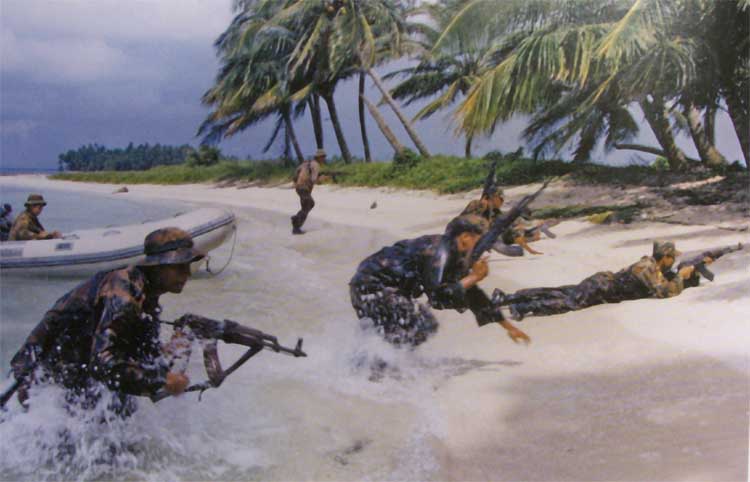
Since November 2006, the inhabitants of El Ocotal, Nueva Segovia, reported a small aircraft and a helicopter flying at low level along the regions of Santa María, San Fernando, Jalapa, Condega and Somoto. The local police chief, Commissioned Héctor Zelaya, acknowledged awareness of unauthorized and unidentified flights taking place from around the community – particularly at night. Lacking the appropriate air assets to intercept the suspects, the government dispatched Army and Police foot patrols to search for clandestine landing strips being used by the intruders in the area. The troops pushed towards the region of Las Camelias, in the San Fernando Mountains close to Honduras.
PNN – National Police
Unfortunately this is a common occurrence in Central America, where the drug traffic has intensified. A month after the mentioned incident in El Ocotal, the Anti-Narcotics Police had intercepted a small launch some 56km from Managua, along the Pacific Ocean, finding some two tons of cocaine in its interior.
The Nicaraguan National Police dedicates considerable resources to fighting the drug traffic, kidnapping rings, and money laundering. Since 2006, the Nicaraguan National Police (PNN) is under the command of First Commissioned Aminta Elena Granera Sacasa, appointed by the previous President Enrique Bolaños Geyer to replace PC Edwin Cordero Ardila. To have a better understanding of the Nicaraguan National Police, this author visited Major Commissioner Aquiles Alonso Sevilla Midence at his PNN Public Relations office at the Main HQ at Plaza del Sol in Managua, who cordially welcomed and provided us with the requested information.
According to the National Census, Nicaragua has some 5,142,098 citizens, which would suggests that the country maintains one of the smallest police institutions in the region. By 2005, the PNN counted with some 8,666 agents, but by the following year, the First Commissioner listed 12,300 professional and reserve officers. These elements derive from a General Directorate, and are distributed between 26 police divisions, including the DAEM, DOEP, INTERPOL, Police Intelligence, Drugs Investigations, and Public Security. The PNN operates from precincts (delegaciones), sub-precincts (sub-delegaciones), police sectors and posts. The precincts are located at Matagalpa, Managua, León, Chinandega, Estelí, Madriz, Nueva Segovia, Carazo, Granada, Masaya, Rivas, Boaco, Chontales, Jinotega, Región Autónoma del Atlántico Norte (RAAN), Región Autónoma del Atlántico Sur (RAAS), Río San Juan, Zelaya Central and Triangulo Minero.
A Development and Modernization Program was implemented in 2001, and the first phase was completed in 2005. This program had its basis on the 1995 Constitutional Reform-Law 228, which dictated the Police Model Regulations, and other necessary documents. In 2002, Disposition 032/02 reorganized the National Police Criminal Investigations Division into a Support Police (Auxilio Policial) and Police Intelligence (Inteligencia Policial) divisions.
The PNN has received considerable support from the European Union, particularly from the Spanish International Cooperation AECI. Spain has dispatched several missions who have assisted in the establishment of the Criminal Lab, and training an equipment of the Immediate Reaction Group (GIR). The Swedish ASDI has provided funds for the construction of 22 police installations, and equipment. The list of benefactors includes the German GTZ, British DFID, Save the Children (Sweden), UNFPA, BID, International Plan, and the Danish DANINA. The China-Taiwan Agency has provided considerable assistance along with JICA-Japan and PNUD-Japan. It is of particular interest that although the locals have suffered numerous wars and huge quantities of weapons remain in civilian hands, the country does not report the same problems with the brutal gangs (Maras) that distinguish the neighbors. It also reports fewer problems with kidnapping rings than other, more prosperous, regional countries.
However, the huge quantities of war-material in the streets has resulted in the establishment the Dirección de Armas, Explosivos, y Municiones (DAEM – Arms-Explosives and Ammunitions Directorate). A bust in 2005 highlight the problem: the PNN confiscated 21 rockets, 462 boxes of Nitroglycerine, seven RPG-7s, 1,802 explosives, two G3 rifles, one Galil, 225 AKMs, eight pistols, three machine guns, 188 other small arms and others in a single raid.
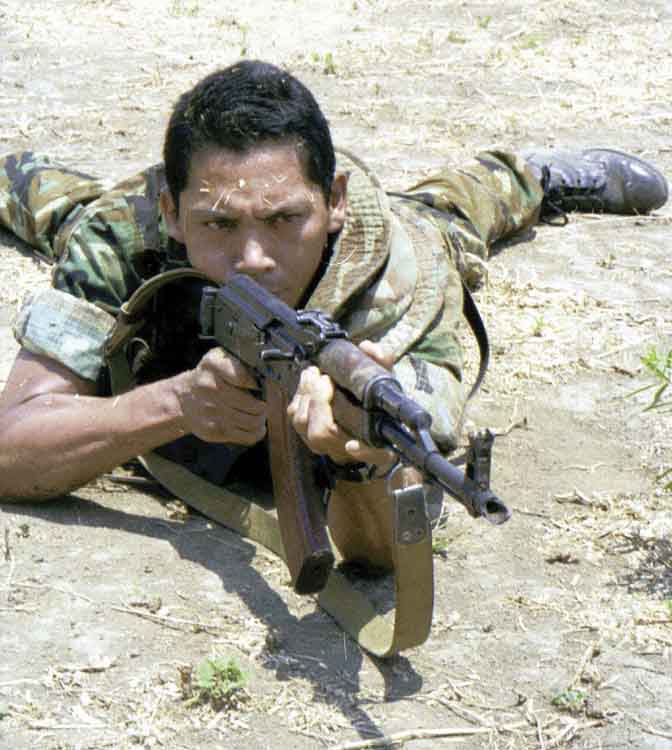
TAPIR, on the other hand, refers to Tácticas y Armas Policiales de Intervención y Rescate – the PNN’s SWAT team – under the DOEP command. The Tapirs are trained by the Army’s COE (Comando de Operaciones Especiales). The unit deploys in pairs, with four operators forming a Team, and several Teams forming patrols and detachments. The organization includes a combat swimmers unit, and their main small arms consists of Uzi and Mini-Uzi SMGs, along with Macro-Galil and Micro-Galil rifles for close quarters operations, and AKM rifles for more conventional operations.
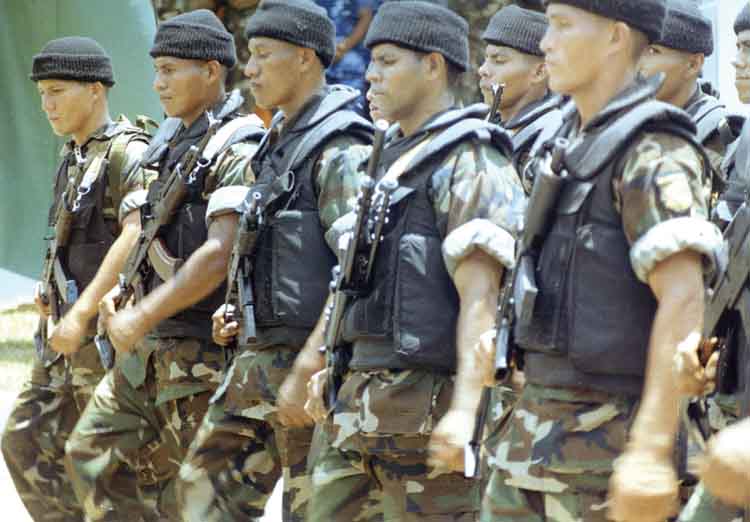
Until recently, the Police Special Operations Direction (DOEP – Dirección de Operaciones Especiales Policiales) comprises the mentioned TAPIR group, the Special Brigade in charge of crown control and physical support, the K9 Unit, the Embassy and Objectives Detail (Departamento de Protección de Embajadas y Objetivos) Operations Department, the Rapid Reaction Group (GIR – Grupo de Intervención Rápida), and two support offices.
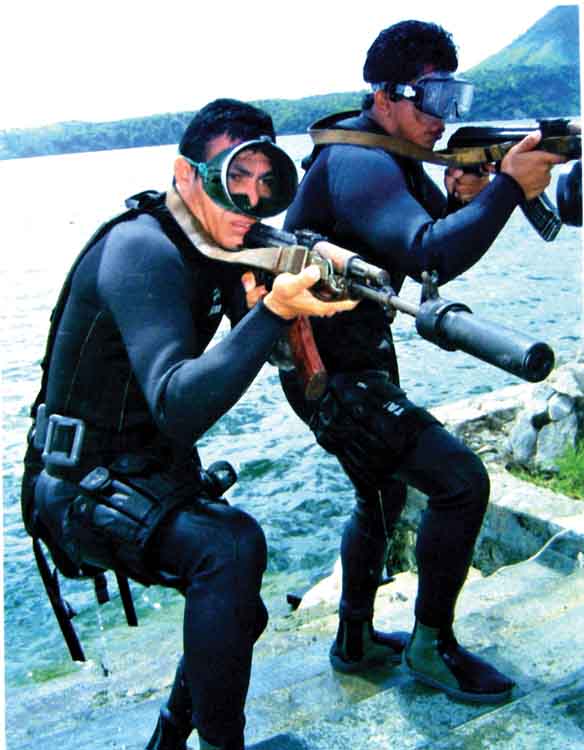
Many of those police units that I was able to observe in Nicaragua patrol the city on extended cab pickup trucks, and indeed the PNN has received some 420 examples by 2006. By comparison, there were 122 patrol cruisers and 804 motorcycles during the same year. By 2003, the PNN had an arsenal consisting of 2,229 pistols; this had increased by 2006 to 4,795 handguns, including 2,566 models acquired during 2004 and 2005. In regards to rifles and shotguns, the PNN listed 3,795 models by June 2006. Small arms totaled 8,590. Most weapons I was able to observed were AKM-S rifles (many of them were the North Korean Type-68), with metallic folding stock. The PNN operates some three Cigarette-type speedboats and a few other launches.
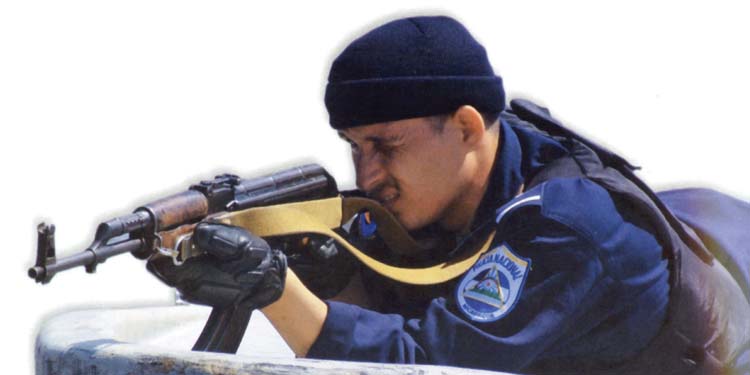
PNN agents must attend and complete their initial training at the Walter Mendoza Martinez Police Academy (ACAPOL), established under Police Law No.228, of 31 July 1996, published on August 23. French advisers have trained the Special Brigade elements, while Spanish advisers have assisted the GIR and the TAPIR. The Nicaraguan police commandos are ready to go anywhere, and at anytime, to accomplish their tasks, responding to the Ministry of Government (Interior).
Army Commandos
With the implementation of the Free Trade Agreement, the Central American governments have agreed to organize a Rapid Reaction Force tasked to fight the drug traffic and international terrorism. It is expected that Nicaragua will dedicate some 600 members of the Army Special Forces Command, Antiterrorist Units, the Air and Naval Forces, and Military Intelligence.
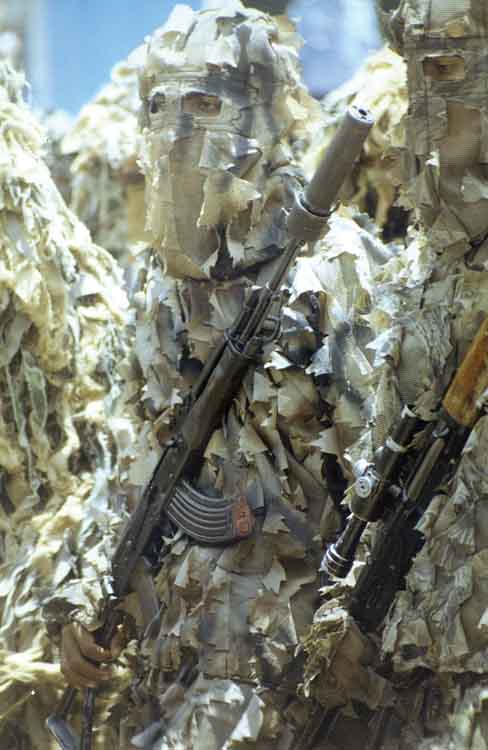
When I first visited the Army’s Special Forces Command nest at the vicinity of the Xiloa Lagoon, the unit was the responsibility of Lt. Col. Rafael Ramírez Gomes. The COE was tasked as the main element of the SAR and Humanitarian Unit, which demanded a deployment within 35 minutes from any alert. This Comando de Operaciones Especiales (C.O.E.) comprises some 600 highly motivated and trained men. Upon arrival we are met by then major and today commander Lt. Col., Manuel Salvador Gaitán, and Cpt. Matamoros, two warriors trained by European Special Forces. They would escort me deep into the base. The first time I came face to face with the Nicaraguan commandos had been long ago, when attending the change of command of the Gral. Humberto Ortega to General Joaquín Cuadra Lacayo, outside Managua. The Nicaraguan Army has always opened its doors to us, allowing several visits to the country and institutions. US forces had the opportunity to work alongside a platoon of these commandos when they formed part of the Chavalo Task Force, attached to the Spanish Plus Ultra Brigade in Iraq.
During the 2nd Civil War between the Sandinistas and the Contras in the 80s, and as a result of the military experience, the Army organized the Batallones de Lucha irregular (BLI). They were trained in airborne techniques, jungle warfare and led by Cuban or Chilean advisers. By 1985, the EPS fielded 13 such units: BLI Simon Bolivar, BIL Coro de Angeles, BLI Ramon Raudales, BLI German Pomares, BLI Juan Pablo Umanzor, BLI Santos Lopez, BLI Miguel Angel Ortez, BLI Farabundo Marti, BLI Sucrates Sandino, BLI Francisco Estrada, BLI Pedro Altamirano, BLI Juan Gregorio Colindres and BLI Rufo Marin. Each of these battalions fielded 700 men equipped with AKM rifles, SVD precision rifles, RPD and RPK machine guns, backed by Soviet 60mm, 82mm and 120mm mortars and AGS-17 grenade launchers. SShK 38/46 12.7mm heavy machine guns were mounted on vehicles and helicopters. Complementing the BLIs were small Light Hunter Battalions (Batallones Ligeros de Cazadores – BLC). They were to operate much in the same manner as Venezuelan hunter battalions, or 250 men divided in two companies. Their mission was to find the enemy and to fix their position so the BLIs then would come to destroy them with their superior firepower and mobility. There were 19 BLC, including the BLC Rigoberto Cruz, BLC Gaspar Garcia Laviana, BLC Oscar Benavides, BLC Modesto Duarte, BLC Edgar Munguía and BLC Adam Gomez.
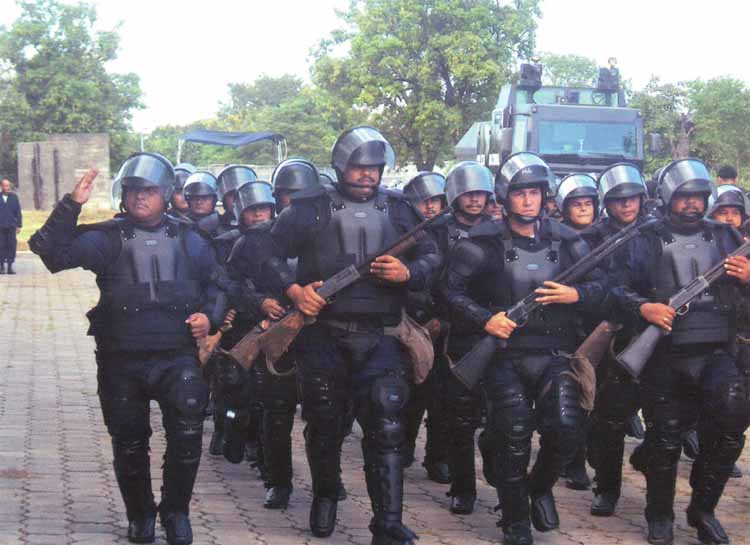
The Contras operated in small battalion-size “task forces,” small-company size “detachments,” and squad size “groups.” These were effective in tying up thousands of troops and destroying the economy. For good measure, the Sandinista government claimed dictatorial powers and established rough and brutal repression, only feeding the Contra ranks. Furthermore, within a brief time after taking over, the FSLN government was pursuing radical economic and social policies at home and building up military strength with the support of the Soviet Bloc. The government also started involving itself on behalf of local and Marxist guerrilla movements in neighboring El Salvador and Guatemala.
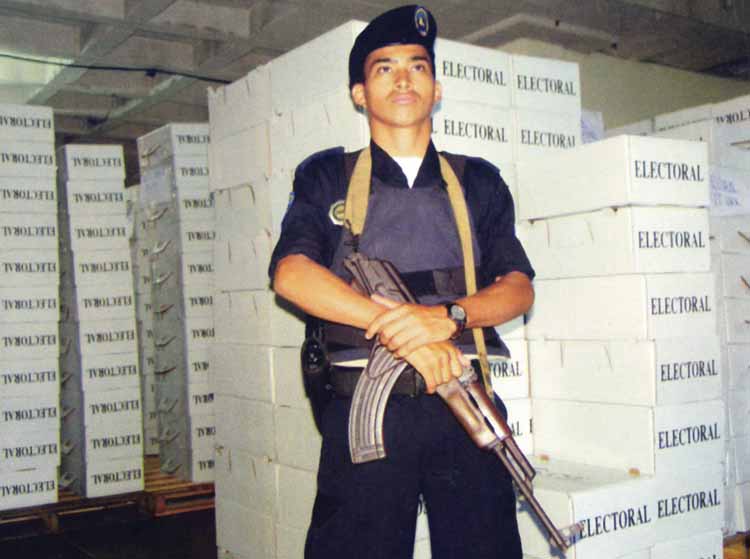
Following Cuban and Soviet doctrine on highly mobile (but heavy) armored formations for forced reconnaissance tasks and as spearhead breakthrough forces, the EPS established the elite Brigada de Tropas “Pedro Altamirano.” Geographically the country divides into three regions. The largest in extent is the triangular mountain region, which occupies the center of the country, to the east of Lake Nicaragua and north of the frontier with Costa Rica. A broad strip of lowland runs north-south, roughly parallel with the Caribbean coast. Another much narrower strip of lowland contains two large lakes, Lake Managua and Lake Nicaragua. The country is mountainous, although not to the extent of some Central American Republics, with peaks as high as 2,000 meters. With the war against counterrevolutionaries coming from Honduras and Costa Rica, the Pedro Altamirano troops had to be ready to fight in any terrain; and they were trained in parachute and reconnaissance techniques at El Cacho, Pinar del Río (Cuba).
However, they remained mechanized, equipped with PT-76 light tanks, BTR-60 APCs, and BRDM armored vehicles, inappropriate for use in the densely-forested mountains. Even so, the Contras managed to destroy only two BRDMs throughout the war. They were ambushed in one of the mountain roads, with the rebels firing dozens of AP 40mm grenades from M79 launchers. The Contras had positions in elevations overlooking the road, and the rounds landed on the lightly protected roof of the BRDMs. Later, the Nicaraguan Spec Ops would adopt the M79 grenade launcher as one of their favorite weapons, many coming from former-National Guard warehouses, and large catches captured to the Contras.
One of the flaws on the use of the Altamirano Brigade was that the Air Force lacked the heavy air transport aircraft necessary for true airborne movement of the heavy equipment. The Army realized that there was a need for something lighter and highly mobile, and with the capacity of taking the fight to the enemy anywhere in the hills. Around 1985, the military decided to include special operations units as part of its order of battle (Orbat). With troops from the Pedro Altamirano brigade and volunteers from the Ministry of the Interior’s (MINIT) Permanent Territorial Companies (COPETE) the Army organized the first Pequeñas Unidades de Fuerzas Especiales (PUFE – Small Special Forces Units).
A PUFE fielded 63 commandos, all trained at El Cacho in Cuba. A year later, the military had increased the PUFEs to three units, forming the first Compañía de Destino Especial (CODE – Special Destiny Company). Soon after, the Batallón de Fuerzas Especiales “Julio Buitrago Urróz” had been organized with three CODEs. By 1986, the CODEs were re-dominated Destacamentos (Detachments), and all the special operations forces were housed at Asturias.
The Spec Ops HQ was moved to Chiltepe, Managua, in 1987, and starting in 1988, the PUFE-BON Julio Buitrago Urroz became the premier tactical unit of the military, adding a reconnaissance, a submarine and an air assault detachment to the three special operations detachments of the order of battle.
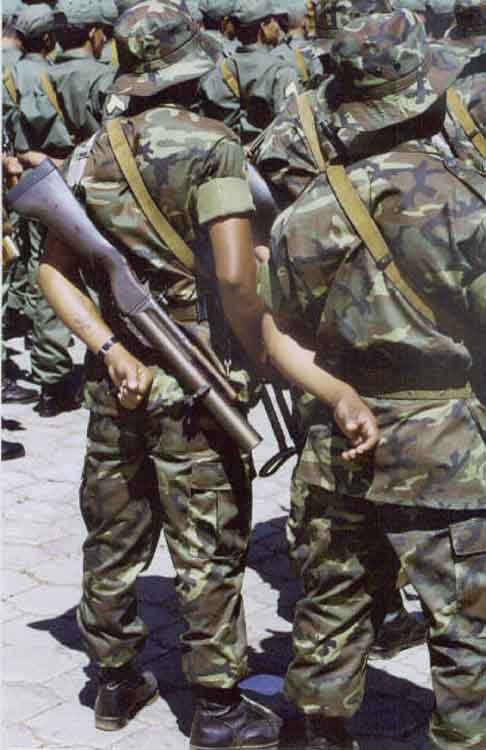
With the Pedro Altamirano Recce Armored Brigade, the BLIs, BLCs, and the CODEs from the EPS and the MINIT’s COPETEs and Border Guards, the Sandinista High Command decided to finish up the Contras once and for all. “Operación Soberanía” was launched along the Costa Rican border against ARDE guerrillas. Spearheading the offensive were the PUFEs of the Buitrago Urroz Battalion and two submarine exploration nucleus from the Pedro Altamirano Brigade.
ARDE, originally led (or misled) by Eden Pastora, had been infiltrated by Sandinista intelligence operatives, and was in disarray due to internal fights. The Sandinista conventional operation – complemented by special operations actions in the rear, and well inside Costa Rica – disarticulated ARDE.
Trying to repeat the same success than Sovereignty, the EPS launched some 10,000 men in “Operación Danto” in March 1988. Danto had as a target the guerrilla camps across the Honduran border. Again COPETEs, BLIs, BLCs, CODE/PUFEs spearheaded the assault. The camps were overrun, and the Contra guerrillas desperately fought back from well inside Honduran territory. The Honduran responded with air support for the guerrillas, and after a few days, reluctantly accepted the US offer to heli-transport troops to the region. There seem to have been a consensus by the Hondurans that the Sandinistas were just taking care of national business by attacking the Contra Camps, even inside their own territory. Eventually, Danto would come to a halt after some Mi-8s had been lost to the Hondurans, and after the US threatened to deploy the 82nd Airborne Division.
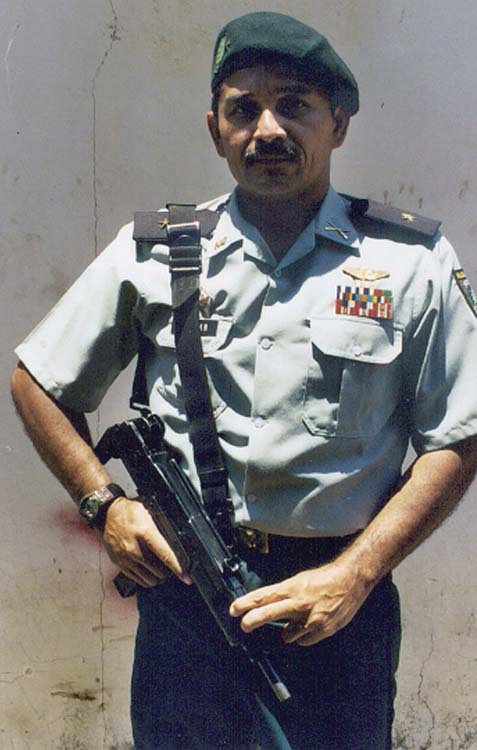
As the war came to an end in 1990, the 13 BLIs were reduced to 13 security companies, and the hunter battalions disbanded, the artillery, tank and mechanized brigades were reduced to a single entity.
C.O.E.
Although the Soviet Union passed into discredited oblivion soon after the dismissal of the Sandinista government, Cuban assistance, particularly for the military, continued until about 1994. Eventually, all assistance from the former Communist Block countries dried up. No positive efforts were initially made to fill the philosophical vacuum left by Nicaragua’s former role models. However, more recent statements and documents, especially in connection with the armed forces, indicate the apparent beginning of an effort to forge a new doctrine more appropriate to present political circumstances and the situation of the country.
Soon after the end of hostilities in 1990, Spec Ops were re-organized in two SF battalions directly under the control of the EPS General Command (Comandancia). The 1st PUFE-BON Buitrago listed the 11th Detachment (DOE-Destacamento de Operaciones Especiales), 12th DOE & 13th DOE as part of its TOE. The 2nd PUFE-BON Altamirano comprised the 21st DOE, 22nd DOE and 23rd DOE. The 2nd PUFE-BON Altamirano was a heavier entity, counting on PT-76 and BRDMs for its operations. Ironically, with the end of the war, the armored assets recovered their importance and elite status due to the new emphasis of the Armed Forces.
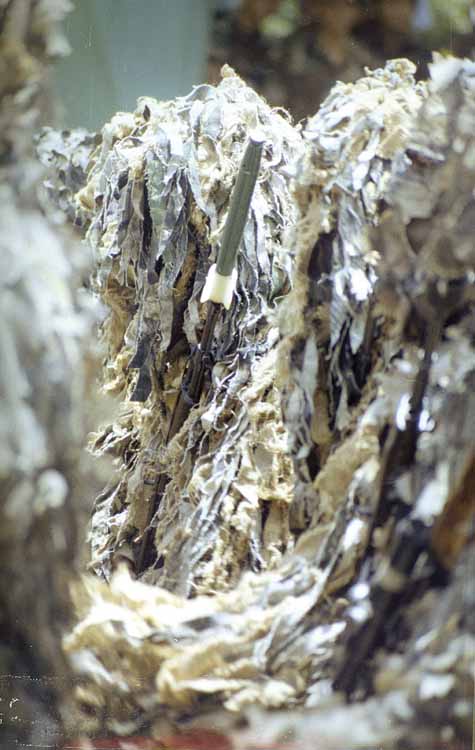
Between 1992 and 1995, the Army went through the peace demobilization process. The Comando de Operaciones Especiales (COE) is established in 1995 as well, and housed in the vicinity of Xiloa Lagoon, close to Managua. The COE was first organized with four Special Operations Detachments (DOES), and a Fire Support Unit. Today, the COE comprises a Support Apparatus, and three Departments: Command, PPUU (Pequeñas Unidades – Small Combat Units), and Security Element. The Pequeñas Unidades de Combate comprises three Special Operations Detachments (1st, 2nd and 3rd DOES), an Anti-Tank Detachment, and a Defense & Fire Support Detachment. Each DOES is divided in binomios (pairs), Equipos (each 5-man), Grupos (each 4 Operational Groups and a Command Team), and Destacamentos (4 Operational and a Command Groups). The COE also deploys one Special Operations Platoon in support of the Northern Military Detachment.
Other Elites
The Air Force handles today a single Compañía de Paracaidistas (Paratrooper Company), comprising some 120 elements divided into a Search and Rescue Detachment, and an Air Special Operations Detachment. The unit has received specialty training by French commandos and Naval Infantry at Martinica.
It is now known that Major Anastasio Somoza Portocarrero’s EEBI prepared the Primera Compañía de Infantería de Marina (1st Marine Company), and the unit was forged by fire in the closing days of the Somoza’s Regimen. The first Naval Infantry units of the modern Nicaraguan military were basically established within the Ministry of the Interior’s (MINIT) Border Guard Troops in the early 1980s. Eventually, the Nicaraguan Sandinista Army would establish several infantry outfits attached to the Naval Force. Today, there is a fusiliers company operating from San Juan del Sur, as part of the local Port Authority; there are also two additional companies assigned to the Naval Regions at the Pacific and the Atlantic, and some detachments assigned to the Northern and Southern Military Detachments. It is specified that these outfits operate in the installation security role and not properly as amphibious units.
There are several issues that afflict the Nicaraguan National Security today, between them elicit weapons, human and drug traffic. The PNN’s Justice Support (DAJ-Auxilio Judicial), the Anti-Narcotics, Financial Investigations (DIE-Investigaciones Económicas), INTERPOL, and the Central Criminal Lab (LCC-Laboratorio Central de Criminalística) divisions coordinate with other 12 Central American Law Enforcement Regional Plan components to fight contraband, drug traffic, money laundering, kidnappings, and other organized crime activities. According to statistics provided by the PNN, the war has netted 6,614 operations between 2000 and 2005, resulting in the seizure of 22,247kgs of cocaine, along with 588,533 marihuana plants and 279.82kgs of heroine.
All this demonstrates that elite outfits of the Ministry of Government’s National Police and the National Army’s elite forces are spearheading the fight against the drug traffic and organized crime anytime and anywhere in Nicaragua.
| This article first appeared in Small Arms Review V14N7 (April 2011) |











